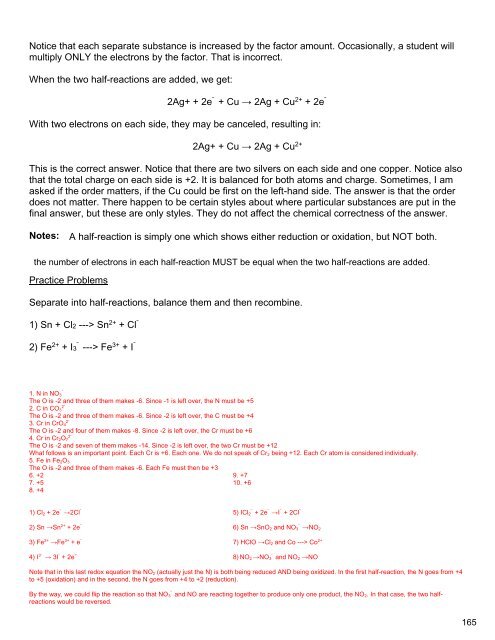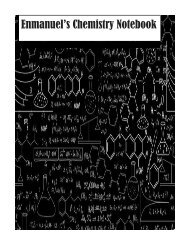You also want an ePaper? Increase the reach of your titles
YUMPU automatically turns print PDFs into web optimized ePapers that Google loves.
Notice that each separate substance is increased by the factor amount. Occasionally, a student will<br />
multiply ONLY the electrons by the factor. That is incorrect.<br />
When the two half-reactions are added, we get:<br />
2Ag+ + 2e¯ + Cu → 2Ag + Cu 2+ + 2e¯<br />
With two electrons on each side, they may be canceled, resulting in:<br />
2Ag+ + Cu → 2Ag + Cu 2+<br />
This is the correct answer. Notice that there are two silvers on each side and one copper. Notice also<br />
that the total charge on each side is +2. It is balanced for both atoms and charge. Sometimes, I am<br />
asked if the order matters, if the Cu could be first on the left-hand side. The answer is that the order<br />
does not matter. There happen to be certain styles about where particular substances are put in the<br />
final answer, but these are only styles. They do not affect the chemical correctness of the answer.<br />
Notes:<br />
Practice Problems<br />
Separate into half-reactions, balance them and then recombine.<br />
1) Sn + Cl2 ---> Sn 2+ + Cl¯<br />
2) Fe 2+ + I3¯ ---> Fe 3+ + I¯<br />
1. N in NO 3¯<br />
The O is -2 and three of them makes -6. Since -1 is left over, the N must be +5<br />
2. C in CO 3<br />
2¯<br />
The O is -2 and three of them makes -6. Since -2 is left over, the C must be +4<br />
3. Cr in CrO 4<br />
2¯<br />
The O is -2 and four of them makes -8. Since -2 is left over, the Cr must be +6<br />
4. Cr in Cr 2 O 7<br />
2¯<br />
The O is -2 and seven of them makes -14. Since -2 is left over, the two Cr must be +12<br />
What follows is an important point. Each Cr is +6. Each one. We do not speak of Cr 2 being +12. Each Cr atom is considered individually.<br />
5. Fe in Fe 2 O 3<br />
The O is -2 and three of them makes -6. Each Fe must then be +3<br />
6. +2 9. +7<br />
7. +5 10. +6<br />
8. +4<br />
1) Cl 2 + 2e¯ →2Cl¯ 5) ICl 2¯<br />
+ 2e¯ →I¯ + 2Cl¯<br />
2) Sn →Sn 2+ + 2e¯ 6) Sn →SnO 2 and NO 3¯<br />
→NO 2<br />
3) Fe 2+ →Fe 3+ + e¯ 7) HClO →Cl 2 and Co ---> Co 2+<br />
4) I 3¯ → 3I¯ + 2e¯ 8) NO 2 →NO 3¯<br />
and NO 2 →NO<br />
Note that in this last redox equation the NO 2 (actually just the N) is both being reduced AND being oxidized. In the first half-reaction, the N goes from +4<br />
to +5 (oxidation) and in the second, the N goes from +4 to +2 (reduction).<br />
By the way, we could flip the reaction so that NO 3¯<br />
and NO are reacting together to produce only one product, the NO 2 . In that case, the two halfreactions<br />
would be reversed.




